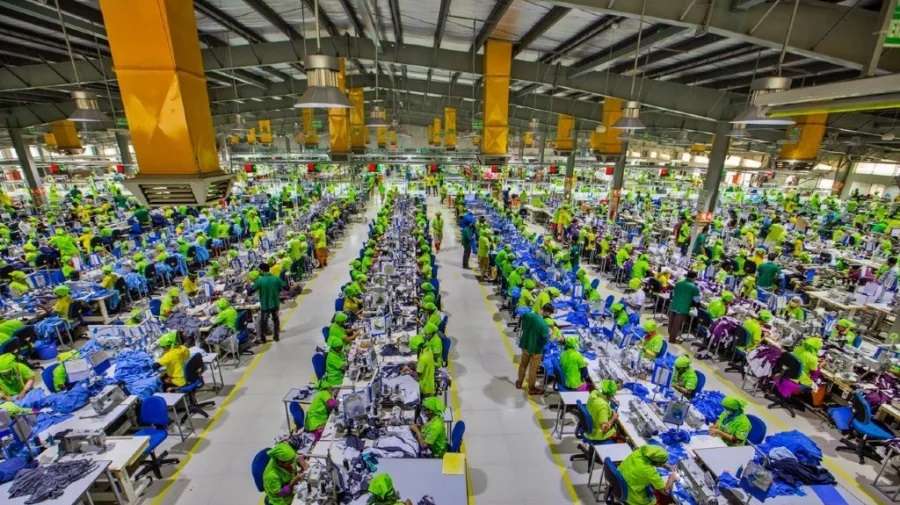
Retailers are betting on Bangladesh’s garment industry more than that of any other country for the coming years show recent studies. Despite the recent deadly factory accidents that have put their reputations at risk.According to a new study by McKinsey & Co, Wall Street Journal, Bangladesh’s $20billion garment business came out ahead of smaller rivalsVietnam and Cambodia in the ranking of countries with the highest potential for future sourcing.
Research showed that production capacity and price appeared to trump safety and labour issues when it came to choosing where to source clothes. Bangladesh has suffered more industrial disasters than any other garment-producing country but its low minimum wage and high number of garment factories has made it a magnet for global retailers, according to the report.
Retailers including H&M, Wal-Mart, Gap and Zara parent Inditex SA are grappling with how the public perceives their role in Bangladesh. Labour unions have pointed fingers at retailers for turning a blind eye to safety violations in factories. The companies have formed safety pacts aimed at improving working conditions which also help improve their image.
A 12-member Alliance delegation headed by its president Jeffrey Krillaare in Dhaka to work out the detailed framework of the safety program including development of a common safety standard.The delegation of the Alliance for Bangladesh Worker Safety reiterated its commitment to completing the proposed inspection of Bangladesh ready-made garment (RMG) factories within the stipulated timeframe.The coalition of North American apparel companies and retailers, industry associations and NGOs was established inJuly to improve workers' safety in Bangladeshi garment factories."The Alliance members informed that they would inspect about 500 garment factories by July 2014," laboursecretaryMikailShipar told the media. He said the Alliance team had also reiterated their assurance that they would carry out their inspection under the national common standards that would be set according to the laws of the land.
The Alliance members have committed more than $45 million to administer the programs and to support the specific ones in the initiative, with some companies offering an additional combined total of over $100 million in loans and access to capital to assist factory owners they work with in Bangladesh targeting factory safety improvement.
Cashmere World, a vertically integrated business platform for the international cashmere trade, will take place from September, 25-26 in Hong Kong. It is a high-quality, annual meeting place for business, a catalyst for fashion trends and technology innovation, as well as a venue for the promotion of the unique qualities of cashmere.
The leading international cashmere trade fair was renamed to Cashmere World in 2010, as a result of a new partnership between CFNA and the professional fair organizer UBM, which operates 110 international events annually.
The event fosters international collaboration of cashmere professionals spanning the various sectors of this specialized industry, from raw materials to finished products, including yarns, fabrics, garments, knitted sweaters, fashion accessories, lifestyle accessories, components and accessories, processing chemicals and dyes and machinery.
The past three events in 2007, 2008 and 2010 attracted some 200 exhibitors from major cashmere supplying countries, including Afghanistan, China, India, Mongolia, Nepal, Pakistan, Switzerland and the UK, displaying the full spectrum of products and services from along the entire cashmere supply chain. About 12,000 visitors from around the world including France, Hong Kong, Italy, Japan, the UK and the US, attended the event.
Apparel exports from Bangladesh to the US recorded a 9 per cent growth in the first seven months of the current calendar year compared to that of the same period of 2012.Bangladesh exported 1.21 billion sq. mtr.apparel products during the first seven months of 2013 to the US market against 1.09 billion sq. mtr.during the corresponding period in 2012.
US imports from Bangladesh totaled $4.9 billion in 2012, an increase of 0.8 per cent from that in 2011 and up by 130 per cent from 2002. The five largest categories of US imports from Bangladesh in 2012 were woven apparel ($3.3 billion), knit apparel ($1 billion), miscellaneous textile products ($ 178 million), headgear ($115 million) and others ($86 million).
Bangladesh is trying hard to bring reforms in its ready-made garment sector. It aims to be one of the best apparel sourcing places in the world and to be the most competitive in the world in terms of both price and quality.
Ultimately it depends on global retailers continuing to have their confidence in Bangladeshi suppliers. And that faith doesn’t seem to have been shaken in spite of the recent tragedies in Bangladeshi apparel factories.
IlyasMehmood of Dawood Exports was elected unopposed as the Chairman of the Pakistan Textile Exporters Association (PTEA). Adil Tahir of Adil Tahir Textiles was elected as vice chairman for 2013-14. Earlier, 12 members were elected to the executive committee of PTEA for the next two years.The new PTEA chief is a seasoned industrialist and heads a group of ultra-modern textile mills. He is serving on the boards of many charitable, health and educational institutions. He plans to tackle problems facing the textile industry like the high utilities cost, the trade deficit, additional levies as well as the law-and-order situation.
The Pakistan Textile Exporters Association was established in 1985. Several of its members have won export merit trophy awards. It handles issues like authentication of applications for drawback claims to exporters, sales tax refund problems and dissemination of textile-related information to members. It proposes suggestions to the government for promotion of exports. It issues certificates of origin of textile items to its members.
A major activity of PTEA is facilitating its members by obtaining favorable market environment in buyer countries by fighting against tariff and non-tariff barriers on textile imports from Pakistan.
www.ptea.org.pk/
In recent months, Myanmar Investment Commission (MIC) has given approval to several foreign businesses to invest in the country’s garment manufacturing sector.Sources reveal two companies, one from the UK and another from Hong Kong, have been given permission to bring in 100 per cent foreign investment for setting up their own business of cutting, making and packing (CMP) apparel in the country recently.
China’s Jiangsu-based Solamoda Garments Group and Hong Kong-based AMG Factory are also among the companies that have got a green signal for investing in Myanmar. In addition, Thailand-based North Star Manufacturing would be setting up a joint venture CMP garment unit with a local partner in Hlaing Tharyar Industrial Zone, also in Yangon.
Singapore-based power companies, UPP Holdings and UPP Greentech, were given approval for producing and selling electricity as wholly-owned businesses at Ywama power station in Yangon Region. Last month, MIC had granted permission to China-based SDI Manufacturing to invest in garment business in Ngwe Pinlel Industrial Zone in Yangon.
The total amount of foreign investment in Myanmar reached over $43 billion at the end of August, with China being the largest investor followed by Thailand and Hong Kong.
Clothing retailers that sold garments made at the collapsed Rana Plaza factory in Bangladesh failed to reach an agreement on compensation after talks, with Primark, saying it will pay more short-term aid.Primark, a unit of Associated British Foods Plc (ABF), said it will pay salaries to all the factory’s workers and their families for three months, declining to disclose the amount. This follows earlier payments and food aid of about $1 million to victims and their families. The retailer has registered the details of 3,333 workers as part of the program. “The company remains concerned about the length of time it is taking to agree on a framework for long-term compensation,” Primark said in a statement recently.
Of the 29 brands that were invited to the recently held meeting in Geneva, only nine attended, the IndustriALL Global Union said in a statement. “Consumers will be shocked that almost half year has passed since the Rana Plaza disaster, with only one brand so far providing any compensation,” Monika Kemperle, Assistant General Secretary of IndustriALL, said in a statement. “I respect those brands that came to these meetings. But I cannot understand brands that are not around the table.”
One of the absentees, Benetton Group SpA, said the meeting wouldn’t provide a framework to address compensation.Benetton, which joined a safety initiative called Bangladesh Fire & Building Safety Accord earlier this year, said it participated in discussions over the last two months that were aimed at setting forth a multi-stakeholder framework to address compensation.“The meeting wouldn’t provide such a structure mainly due to lack of clarity around the objectives as well as the nearly complete the lack of involvement allowed to several key stakeholders,” Benetton Chief Executive Officer BiagioChiarolanza said in a statement.
Bangladesh's garment industry has been hit by a dispute between factory owners and workers over minimum wages.Labor groups are demanding a big increase to offset the impact of high inflation rate that has often climbed above 10 per cent in the country. Factory owners say a higher minimum wage could hobble the industry as costs of other inputs are also rising, in addition to which demand from many Western markets is weak.
In June, Bangladesh's Ministry of Labor and Employment formed a committee with factory owners, workers and government representatives to review wages in the garment sector. The committee is supposed to report back with a negotiated solution by December.
Bangladesh's garment industry exported more than $20 billion of clothes in the fiscal year ended June 30 and employs roughly four million workers. About 80 per cent of the people in the industry are women and most of them are from poor, rural areas.
Bangladesh’s readymade garment sector is a ready market for textile goods, so investors' interest in the textile industry is increasing.Local and foreign entrepreneurs have been coming forward with fresh investment or reinvestment in the textile sector. A total of 1,457 fresh investment proposals were registered from local investors in fiscal year 2012-13. Since the readymade garment sector is growing significantly, demand for backward linkage accessories, including fabrics and textile items, is also rising.
Most textile units in the country are going to double their production capacity to meet the growing demand for fabric and yarn at home and abroad. Due to fresh investments, and growing demand for textile items, cotton consumption in Bangladesh will increase by seven per cent this fiscal year.
The textile sector is getting popularity among local and foreign investors thanks to export-oriented industries enjoying different types of incentives like tax holiday, warehouse facility and others.
The United Nations is monitoring garment factories in Cambodia, particularly worker’s rights and safety standards. Accidents have occurred in Cambodia recently, including two at factories in May, one of which left two people dead.The program is known as ‘Better Factories Cambodia’. It inspects manufacturing facilities for problems such as child labor and unsafe conditions and offers training for factories to upgrade.
Better Factories plans to release information on a new website about the performance of all factories it has inspected at least twice regarding 21 issues, such as wages, worker rights, fire safety and treatment of unions. But some people in Cambodia have opposed the program, saying it could wind up exposing factory owners to public ridicule.
Currently, Better Factories Cambodia submits confidential reports to factories, whose business partners have the option to buy them. It also publishes public summaries that don't name plants. Under the new program, factories that have had three or more Better Factories inspections and still fall two standard deviations below the mean for compliance will be subject to an even higher level of disclosure.












